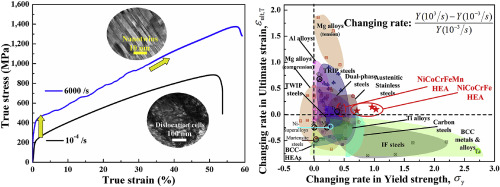当前位置:
X-MOL 学术
›
Int. J. Plasticity
›
论文详情
Our official English website, www.x-mol.net, welcomes your
feedback! (Note: you will need to create a separate account there.)
Simultaneous enhancement of strength and ductility in a NiCoCrFe high-entropy alloy upon dynamic tension: Micromechanism and constitutive modeling
International Journal of Plasticity ( IF 9.4 ) Pub Date : 2020-01-01 , DOI: 10.1016/j.ijplas.2019.08.013 T.W. Zhang , S.G. Ma , D. Zhao , Y.C. Wu , Y. Zhang , Z.H. Wang , J.W. Qiao
International Journal of Plasticity ( IF 9.4 ) Pub Date : 2020-01-01 , DOI: 10.1016/j.ijplas.2019.08.013 T.W. Zhang , S.G. Ma , D. Zhao , Y.C. Wu , Y. Zhang , Z.H. Wang , J.W. Qiao

|
Abstract The deformation responses of NiCoCrFe high-entropy alloy (HEA) under quasi-static (1 × 10−4-1 × 10−1/s) and dynamic (1,000–6,000/s) tension were investigated. A good combination of high strength and ductility is obtained under dynamic tension. The yield strength and true ultimate tensile strength is increased from 217 to 830 MPa at 1 × 10−4/s to 440 MPa and more than 1,000 MPa at 6,000/s, respectively. In addition, the engineering fracture strains maintain 60%–85% over a wide range of strain rates. The enhancements of strength and ductility originate from (1) the significant strain-rate sensitivity (SRS) mainly due to the presence of short-range orders/clusters (SROs/SRCs) as well as phonon drag effect of dislocations, and (2) the extraordinary work-hardening capacity due to dynamically formed nanoscale twins upon high strain-rate tension. The temperature and strain-rate dependence of the yield strength of the alloy are well modeled based on the thermally activated mechanism. Additionally, considering nanoscale twin boundaries as local sites for nucleating and accommodating dislocations, the dislocation density evolution model is modified and subsequently introduced into Taylor hardening model to accurately capture the hardening behavior of the current NiCoCrFe HEA. Hence, the distinguished work-hardening capacity under dynamic tension can be mainly ascribed to the low dislocation recovery rate and remarkable twin-induced dislocation generation.
中文翻译:

NiCoCrFe 高熵合金在动态张力下强度和延展性同时增强:微观机制和本构建模
摘要 研究了 NiCoCrFe 高熵合金 (HEA) 在准静态 (1 × 10−4-1 × 10−1/s) 和动态 (1,000–6,000/s) 张力下的变形响应。在动态张力下获得了高强度和延展性的良好结合。屈服强度和真实极限抗拉强度分别从 1 × 10−4/s 时的 217 到 830 MPa 增加到 6,000/s 时的 440 MPa 和超过 1,000 MPa。此外,工程断裂应变在很宽的应变率范围内保持 60%–85%。强度和延展性的增强源于(1)显着的应变率敏感性(SRS),主要是由于短程有序/簇(SRO/SRC)的存在以及位错的声子拖曳效应,以及(2)由于在高应变率张力下动态形成的纳米级孪晶,具有非凡的加工硬化能力。合金屈服强度的温度和应变速率依赖性基于热激活机制很好地建模。此外,考虑到纳米级孪晶边界作为成核和容纳位错的局部位点,位错密度演化模型被修改并随后引入泰勒硬化模型,以准确捕捉当前 NiCoCrFe HEA 的硬化行为。因此,动态张力下卓越的加工硬化能力主要归因于低位错恢复率和显着的孪生诱导位错产生。考虑到纳米级孪晶边界作为成核和容纳位错的局部位点,位错密度演化模型被修改并随后引入泰勒硬化模型,以准确捕捉当前 NiCoCrFe HEA 的硬化行为。因此,动态张力下卓越的加工硬化能力主要归因于低位错恢复率和显着的孪生诱导位错产生。考虑到纳米级孪晶边界作为成核和容纳位错的局部位点,位错密度演化模型被修改并随后引入泰勒硬化模型,以准确捕捉当前 NiCoCrFe HEA 的硬化行为。因此,动态张力下卓越的加工硬化能力主要归因于低位错恢复率和显着的孪生诱导位错产生。
更新日期:2020-01-01
中文翻译:

NiCoCrFe 高熵合金在动态张力下强度和延展性同时增强:微观机制和本构建模
摘要 研究了 NiCoCrFe 高熵合金 (HEA) 在准静态 (1 × 10−4-1 × 10−1/s) 和动态 (1,000–6,000/s) 张力下的变形响应。在动态张力下获得了高强度和延展性的良好结合。屈服强度和真实极限抗拉强度分别从 1 × 10−4/s 时的 217 到 830 MPa 增加到 6,000/s 时的 440 MPa 和超过 1,000 MPa。此外,工程断裂应变在很宽的应变率范围内保持 60%–85%。强度和延展性的增强源于(1)显着的应变率敏感性(SRS),主要是由于短程有序/簇(SRO/SRC)的存在以及位错的声子拖曳效应,以及(2)由于在高应变率张力下动态形成的纳米级孪晶,具有非凡的加工硬化能力。合金屈服强度的温度和应变速率依赖性基于热激活机制很好地建模。此外,考虑到纳米级孪晶边界作为成核和容纳位错的局部位点,位错密度演化模型被修改并随后引入泰勒硬化模型,以准确捕捉当前 NiCoCrFe HEA 的硬化行为。因此,动态张力下卓越的加工硬化能力主要归因于低位错恢复率和显着的孪生诱导位错产生。考虑到纳米级孪晶边界作为成核和容纳位错的局部位点,位错密度演化模型被修改并随后引入泰勒硬化模型,以准确捕捉当前 NiCoCrFe HEA 的硬化行为。因此,动态张力下卓越的加工硬化能力主要归因于低位错恢复率和显着的孪生诱导位错产生。考虑到纳米级孪晶边界作为成核和容纳位错的局部位点,位错密度演化模型被修改并随后引入泰勒硬化模型,以准确捕捉当前 NiCoCrFe HEA 的硬化行为。因此,动态张力下卓越的加工硬化能力主要归因于低位错恢复率和显着的孪生诱导位错产生。











































 京公网安备 11010802027423号
京公网安备 11010802027423号